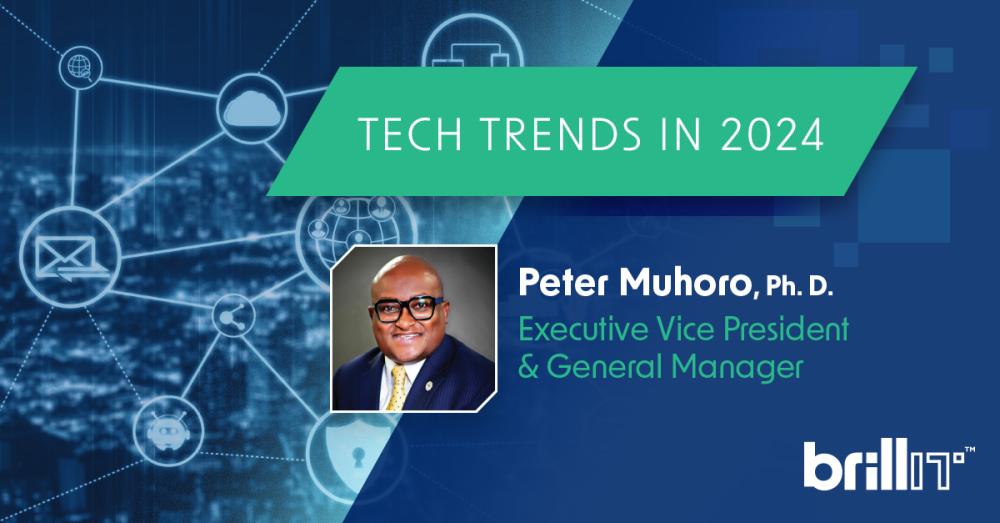By Dr. Peter Muhoro, Executive Vice President and General Manager, BrilliT and Chief Strategy, Technology, and Innovation Officer, Rappahannock Electric Cooperative
As we navigate through the early stages of 2024, the pace at which technology evolves continues to astonish and challenge us in equal measure. With every passing month, we encounter new hurdles and prospects, particularly within the realms of cybersecurity, data analytics, and artificial intelligence.
Here are a few areas we’re keeping our eyes on while heading into the rest of 2024.
Global Politics, the Economy, and Cyber Warfare Risks
The intensification of global political tensions has led to a noticeable uptick in cyber-attacks targeting critical infrastructure. These developments underscore the critical need for exhaustive cybersecurity evaluations and the execution of simulation drills. These measures are paramount in preparing for and diminishing such threats. Adopting a proactive approach is indispensable, a principle that is increasingly becoming a cornerstone across all sectors we monitor.
In response to these escalating threats, there's a growing reliance on AI-driven cybersecurity defense mechanisms. These systems leverage machine learning algorithms to predict, detect, and respond to cyber-attacks in real-time, significantly enhancing the resilience of critical infrastructure against sophisticated cyber threats.
Evolving Social Engineering Techniques
The democratization of AI technology has led to the refinement of social engineering attacks. Impersonations of high-level executives, for example your CEO, once easily detectable, have become alarmingly convincing. This evolution mandates a shift from proactive strategies to indispensable defense mechanisms. Services like Managed Detection and Response (MDR) and Ransomware Early Warning systems are becoming vital in identifying and neutralizing these advanced threats.
The implementation of blockchain technology is emerging as a potent tool against social engineering threats. By ensuring the integrity and traceability of digital communications and transactions, blockchain technology can significantly mitigate the risk of these sophisticated social engineering attacks.
Innovations with AI Visual Applications
BrilliT’s work with tools such as Streamlit in Snowflake are revolutionizing data analytics. These advancements automate processes, generate intelligent reports, and facilitate the creation of predictive models, signifying a shift towards more efficient and data-centric operational processes.
The integration of Edge AI with visual analytics tools is setting new standards for real-time data processing and analysis. This combination allows for the processing of vast amounts of data locally on devices, reducing latency and enhancing decision-making processes in various industries.
Integration of Large Language Models
The assimilation of large language models into utility databases is significantly improving data accessibility and analysis. This innovation is set to redefine data utilization, enabling more informed and timely decision-making.
Federated learning is becoming a pivotal approach in enhancing privacy in the use of large language models. By training algorithms across multiple decentralized devices or servers without exchanging data samples, this technique ensures data privacy and security, a critical aspect as data regulations become increasingly stringent.
Strides in Data Interoperability
Our commitment to unifying diverse data sources is aimed at providing a comprehensive view of operations, particularly for electric cooperatives. This initiative is crucial for generating predictive insights that support strategic planning and resource allocation. Our analytics dashboards continue to evolve, offering meaningful insights to decision-makers at every level, including CEOs and Boards.
Quantum computing is poised to play a significant role in data interoperability and analysis. With its unparalleled processing power, quantum computing can analyze data from disparate sources more efficiently than traditional computers, opening new avenues for predictive modeling and complex problem-solving.
As 2024 unfolds, BrilliT remains at the forefront, vigilantly monitoring these and other technological advancements. Our goal is not only to meet the current challenges but also to anticipate future trends, ensuring that our solutions remain innovative, relevant, and effective. Join us on this journey, as we explore the vast potential of technology together.
About the Author Dr. Peter Muhoro leads the development and monitoring of long- term strategies related to technology systems, new service offerings, and business planning. He is an accomplished electric utility executive with over 15 years of experience in the energy industry. He has consulted with hundreds of electric utilities on new and emerging technology trends, and presented, keynoted or served on a panel at over 500 conferences and events. His leadership addresses not only the needs of today, but more importantly, the technology needs of tomorrow.
Dr. Peter Muhoro leads the development and monitoring of long- term strategies related to technology systems, new service offerings, and business planning. He is an accomplished electric utility executive with over 15 years of experience in the energy industry. He has consulted with hundreds of electric utilities on new and emerging technology trends, and presented, keynoted or served on a panel at over 500 conferences and events. His leadership addresses not only the needs of today, but more importantly, the technology needs of tomorrow.
He holds a Bachelor of Science in Physics and Mathematics from Hampton University, a Master of Science and Ph.D. in Applied Physics from the University of Michigan.


